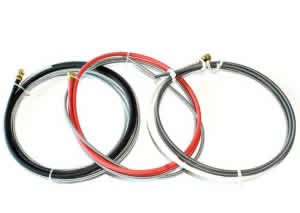Mig Welding Liners
call us today
- 1-800-567-1362

MIG welding liners are both one of the simplest and most important components of a MIG gun. The sole purpose of MIG welding liners are to guide the welding wire from the wire feeder, through the gun cable and up to the contact tip.
A number of problems can interfere with the liner’s ability to properly guide the wire through the welding cable. When the wire does not feed correctly, weld quality problems may arise that lead to increased operator downtime and costs.
Optimizing Performance
Proactive maintenance can eliminate problems before they arise and reduce operator downtime, more serious equipment failures and costs.
Buy quality
A premium quality liner maintains a consistent inside diameter throughout its length. This is critical because variances as small as a few thousandths of an inch can result in wire feeding problems requiring time-consuming liner replacement.
Choose the right size
To maximize the performance of your MIG equipment, choose the correct liner size for the wire being used.
Small diameter welding wires, .023-in. through .045-in., have relatively low columnar strength, which, when paired with an oversized liner, can cause the wire to wander or drift within the liner. This in turn leads to poor wire feeding and premature liner failure due to excessive wear.
By contrast, larger diameter welding wires, 1/16-in. through 1/8-in., have much higher columnar strength. Just make sure the liner you choose is large enough to feed the welding wire you are using.
Proper replacement
Improperly installing the liner can lead to wire feeding problems such as birdnesting. Avoid twisting the cable when trimming the liner, as this can cause it to be too short, resulting in gaps that can lead to erratic wire feeding.
There are also consumables — contact tip, nozzle, gas diffuser and liner — available in the marketplace that allow for error-proof liner installation. The diffuser locks the liner in place and concentrically aligns it with both the power pin and contact tip with no gaps or misalignments (and without the use of fasteners). There is no liner measuring required during installation or replacement. The welding operator or maintenance personnel simply feeds the liner through the neck of the gun, locks it in place and cuts the liner flush with the back of the power pin.
Regular maintenance
Tight bends in the cable increase friction between the liner and the welding wire. This friction makes it more difficult to push the wire through the liner, causing wear and metal fragments to accumulate inside the liner. Eventually these tiny particles can build up and cause serious wire feed blockages.
Troubleshooting
Poor or erratic wire feeding, a loss of amperage or frequent contact tip burnback are all signs of liner problems.
Poor wire feeding
Erratic or poor wire feeding can result when the liner becomes worn out in certain spots, is trimmed incorrectly during replacement or has excessive debris buildup in the liner. Excessive debris can usually be cleared out by removing the wire and forcing compressed air through the liner.
In most cases, a worn out liner will need to be replaced. With a conventional liner, trimming the liner accurately during replacement is critical. Using a liner gauge is recommended when trimming a conventional liner. Another option is to use a consumables system that locks the liner in place at the front and back of the gun while concentrically aligning it to the contact tip and power pin. With this type of system, the liner is simply trimmed flush with the power pin at the back of the gun — no measuring required.
Birdnesting
If the welding wire’s path of travel through a MIG gun is blocked while the wire feeder is pushing it, a tangled mess of wire called a birdnest could be the result. A birdnest can be caused by a liner that is trimmed too short, clogged, or the wrong size.
Electrical short
The liner is not designed to carry welding current, so a dramatic loss of current at the arc will result if loose cable connections or a degraded cable make it the path of least electrical resistance. One common sign that this has occurred is a discolored liner and excessive heat build up along the power cable. The discoloration is caused by heat and indicates weld current is being carried through the liner instead of the gun’s power cable. A degraded cable will require repair or replacement.
Performing some very basic maintenance and being able to troubleshoot a malfunctioning liner will help you maintain consistent weld quality and optimum productivity.
Our mig liners are precision wound to stringent standards for excellent fit and long life. SUPERIOR CONSUMABLES liners are available in many popular brands of High carbon music wire for smooth wire feed and long life. SUPERIOR CONSUMABLES liners are available in common lengths to 25′ (7.6 m) for all wire sizes and most every Robotic and Manual welding application.
SUPERIOR CONSUMABLES are the only WISE CHOICE for your tough welding applications. That’s because they offer the same high performance as original equipment consumables.
SUPERIOR CONSUMABLES deliver the performance and reliability you need to minimize your production costs while maximizing welding efficiencies!
Contact us for pricing and availability.
We Manufacture:
All of our welding tips are made from the highest quality ISO Extruded Tubing.
Schedule Your FREE Trial
in North America
Superior Consumables product is backed by proven, documented test results.
For All Your Mig Welding Needs!
Many self proclaimed ORIGINAL manufacturers contract out a large percentage of their consumable manufacturing needs and just charge a higher price for their logo and packaging. Some even go as far to make statements that the warranty is not valid if their Original brand consumables are not used. The WISE purchaser knows that these statements are false and misleading and are contravening to the MAGNUSON MOSS act in the USA and against the COMPETITION ACT in Canada.
